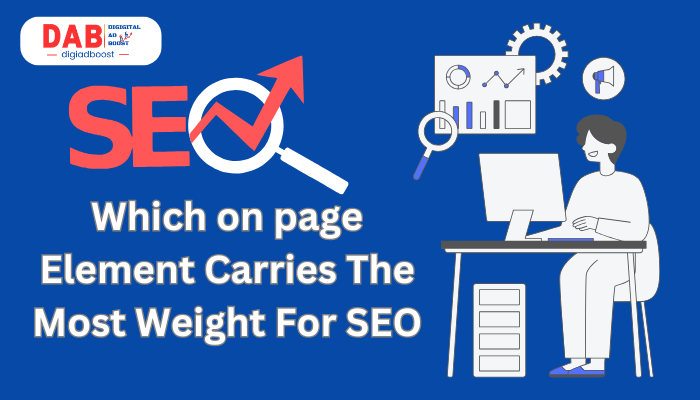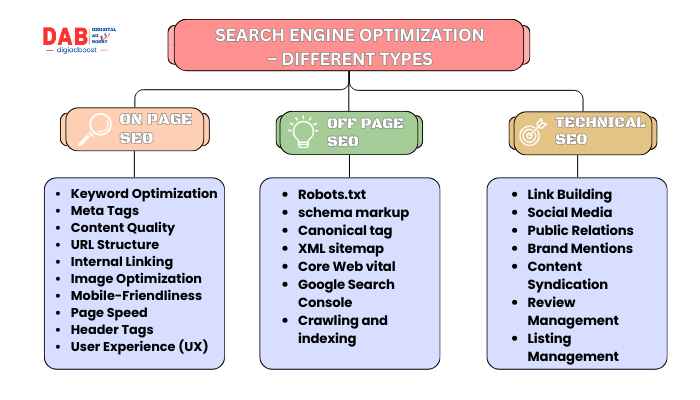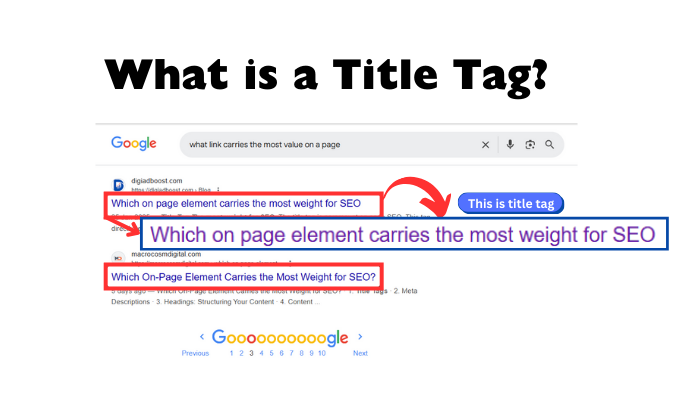
Which on page element carries the most weight for SEO
Table of Contents
ToggleYou want to know which On-page Element is most important for SEO, then you have come to the right place. In short, while SEO optimizes your website for search engines like Google, there are many factors that play a role in ranking your website on SERP. SEO (Search Engine Optimization) refers to the process of optimizing websites to enhance their ranking on search engines such as Google. It entails methods such as keyword research, content optimization, link building, and technical optimization to drive organic traffic. Proper SEO enables businesses to rank higher in search results, enhancing online visibility, credibility, and audience engagement.
Search Engine Optimization – Different Types for Seo

On-Page SEO : Site optimization at the page level, concerning title tags, meta descriptions, headers, and content quality.
Off-Page SEO : Relates to activities outside the website, such as link building, social media marketing, and outreach from influencers.
Technical SEO : Improves infrastructure by optimizing site speed, mobile-friendliness, and XML sitemaps.
On-page SEO focuses on the modifications of individual pages to rank well in search engines, attracting the proper crowd. Therefore, it involves refining the content and HTML setup of a website with regard to a better user experience. The essential parts are given below.
- Keyword Optimization:- Use important keywords naturally in titles, headings, meta descriptions, and in the content.
1.Keyword Research:-Utilize free tools such as Google Keyword Planner, Ubersuggest, and Answer ThePublic to discover related keywords. Target search intent (informational, navigational, transactional, or commercial). Find long-tail keywords that are less competitive but highly targeted.
2. Keyword Selection Prioritize high-search-volume, low-competition keywords. Blend short-tail (broad) and long-tail (specific) keywords. Use LSI (Latent Semantic Indexing) keywords to add context.
3. Keyword Placement (On-Page SEO) Title Tags: Place primary keywords first. Meta Descriptions: Use interesting copy with relevant keywords. Headings (H1, H2, H3): Optimize naturally using keywords. URL Structure: Keep it short and keyword-rich. Body Content: Use keywords naturally without keyword stuffing. Alt Text for Images: Use descriptive keywords to optimize image SEO. Internal Linking: Use anchor text using relevant keywords.
4. Competitor Analysis Compare competitors using SEMrush, Ahrefs, or Moz to find keyword gaps. Find keywords that bring traffic to their websites and plan accordingly.
- Meta Tags:- Create interesting title tags and meta descriptions that have main keywords.
1.Title Tag (Meta Title) Purpose: Displays the clickable title in search results. Best Practices: Limit it to 50-60 characters. Insert the main keyword naturally. Make it enticing to increase CTR (Click-Through Rate).
2.Meta Description Purpose: Brief description of the page content displayed in search results under the title. Best Practices: Limit it to 140-160 characters. Include a call-to-action (CTA) to click. Insert the main keyword naturally.
- Content Quality:- Share high-quality, original, and engaging content that matches what users want.
1. Content Relevance & Value Ensure content is user intent-specific (informational, navigational, transactional). Offer unique insights, research, or case studies rather than generic facts. Ensure the content is fresh and in sync with industry trends.
2. Readability & Structure Use brief paragraphs, bullet points, and subheadings for easy scans. Use simple and conversational tone (avoid jargon if not necessary). Ensure logical flow with proper introduction, body, and conclusion.
3. SEO Optimization Employ primary & secondary keywords organically (avoid keyword stuffing). Optimize meta titles, descriptions, and headers with keywords. Use internal linking for better navigation and lower bounce rates.
4. E-E-A-T Compliance (Expertise, Experience, Authoritativeness, Trustworthiness) Employ author credentials or industry expertise. Employ links to credible sources (official reports, case studies). Employ transparency with fact-based content.
- URL Structure:- Keep your URLs short, descriptive, and keyword-rich.
- Internal Linking:- Connect relevant pages on your website to improve navigation and authority.
- Image Optimization:- Use descriptive file names, alt text, and compress images for faster loading.
- Mobile-Friendliness:- Make sure your site is responsive and gives an amazing experience on all devices.
- Page Speed:- Optimize the load times by reducing server response time and use caching.
- Header Tags:- Use H1, H2, and other header tags to structure content hierarchically.
- User Experience (UX):- Make your site easy to navigate, readable, and visually appealing.
Title Tag-The most weight for SEO
The title tag is paramount on page SEO. This tag directly tells the browsers what the web page is about, appearing as the users’ first sight in the search results. A well-optimized title tag usually includes primary keywords, is not over 60 characters long, and draws people’s attention the most. Header tags (H1, H2), which give a structural framework to the contents and the meta description, which is a sales pitch to users for the idea of the web page ranking come under the category of the essential elements. Furthermore, the good quality, keyword abundant content and the proper URL structure are the two primary factors that dramatically affect SEO. These things, when put together, provide better chances of being presented to users and increased user interaction.
What is a Title Tag?

A title tag is a crucial element of HTML that specifies the title of a web page. It is playing a dual role in the Web: optimization for search engines (SEO) and convenience for users. The title tag is the text you will see in the following places:
- Search Engine Results Pages (SERPs) • The title tag is a clickable headline displayed in search results.
- Browser Tabs: • Is the title that appears on the tab of the web browser, showing you what the tab is about and allowing you to switch to the other pages.
- Social Media Previews: • Titles are often used by the platforms as the headline for the shared content.
Why is the Title Tag Important in SEO?
- Improves Search Engine Rankings: • Search engines use the title tag to understand the content of a page and its relevance to search queries.
- Increases Click-Through Rates (CTR): • With an attractive and optimized to keywords title users are redirected to your page directly from SERPs.
- Sets User Expectations: • It gives a short and clear idea of what page users can expect to browse.
- Boosts Brand Recognition: • Specifying your brand name in the title tag serves as a reinforcement of your identity in the search result.
Best Practices for Writing a Title Tag
- Keep It Short and Concise: • Just writing a 50-60 character length will be ideal to avoid trunks of the title in SERPs.
- Include Primary Keywords: • Always insert the most important keyword as the first word of the title to achieve more growth of SEO.
- Make It Unique: • Each page should own a unique title in order to avoid the competition of keywords vs. other pages.
- Use Compelling Language: • Include power words “best”, “ultimate”, “guide” or any numbers to get the attention.
How to Write a Catchy Title Tag
It is writing interesting and SEO friendly title tags, which is a must not only for getting search engine rankings but also getting excellent click-through rates or CTR. This is the step-by-step breakdown on how to make good title tags that attractively draw in viewers:
Steps in Writing Catchy Title Tag
Include Primary Keywords Early
- Put the primary keyword in the title tag toward the front. •
- Example: “Digital Marketing Strategies for 2025 | Boost Your ROI.
Keep It Brief
- Limit the title to 50-60 characters to prevent truncation in search results.
- Example: “Top SEO Tips to Rank Higher in 2025.
Address User Intent •
- Match the title to what users are looking for (informational, transactional, or navigational intent).
- Example: “How to Create a Winning Social Media Strategy.
Make It Compelling
- Use power words or emotional triggers such as “best,” “ultimate,” “guide,” “proven,” or “free.”
- Example: “The Ultimate Guide to Email Marketing Success.
Add a Call-to-Action (CTA)
- Make users click by employing action-oriented words such as “Learn How,” “Discover,” or “Try.”
- Example: “Discover the Secrets of Successful Content Marketing.

very informational blog
Pingback: What is Blogging in Digital Marketing?
Pingback: Which on page element carries the most weight for SEO